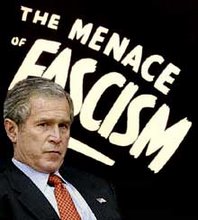There is definitely something very rotten gong on in lower Manhattan.
Obscure Company Is Behind 9/11 Demolition Work
The John Galt Corporation of the Bronx, hired last year for the dangerous and complex job of demolishing the former Deutsche Bank building at 130 Liberty Street, where two firefighters died last Saturday, has apparently never done any work like it. Indeed, Galt does not seem to have done much of anything since it was incorporated in 1983.
Public and private records give no indication of how many employees it has, what its volume of business is or who its clients are. There are almost no accounts of any projects it has undertaken on any scale, apart from 130 Liberty Street. Court records are largely silent. Some leading construction executives in the city say they have never even heard of it.
That may not be as surprising as it seems. John Galt, it appears, is not much more than a corporate entity meant to accommodate the people and companies actually doing the demolition job at the emotionally charged and environmentally hazardous site at the edge of ground zero.
The companies and project managers who have been providing the expertise, the workers and the financing for the job are Regional Scaffolding and Hoisting Company, which is not in business to demolish skyscrapers, and former executives from Safeway Environmental Corporation, a company that was already removed from one contract at 130 Liberty because of concerns about its integrity.
Using a separate corporation to insulate the assets of a parent company from the enormous potential liabilities of demolition work is not itself unusual. And challenging construction projects in the city often have several companies come together in a joint effort.
The arrangement involving Galt — achieved after multiple companies that had bid on the Deutsche Bank contract were eliminated for one reason or another — is nonetheless odd for such a momentous job, one that is expected ultimately to cost roughly $150 million.
The arrangement, never fully publicly disclosed, was proposed by the general contractor charged with overseeing the demolition, Bovis Lend Lease, and approved by the Lower Manhattan Development Corporation, which owns 130 Liberty Street.
Yesterday, Bovis announced that it had declared Galt in default on the bank building contract, saying the outfit Bovis had selected had failed “to live up to terms of its contract with respect to site supervision, maintenance and project safety.” One person who has spoken to Bovis executives, but who was not authorized to speak for the company, said it was likely that Galt would be formally fired within the week.
When officials at the Lower Manhattan Development Corporation approved Galt’s participation, they even allowed two former senior Safeway executives to join the operation at the Deutsche Bank building on several conditions, including that they cooperate with an investigation being conducted by the city’s Department of Investigation.
In the 17 months since Galt took shape — and as problems mounted at the demolition site, including repeated safety violations — city and state officials have made announcements about the work and problems at 130 Liberty referring to John Galt as if it were a fully established corporation, and never mentioning by name the more controversial and less than perfectly qualified people and companies doing the work.
(John Galt, by the way, is a central character, an engineer, in Ayn Rand’s novel “Atlas Shrugged.” The book begins with this line: “Who is John Galt?”)
John Galt’s stationery puts its headquarters at 3900 Webster Avenue in the Bronx, near Woodlawn Cemetery, the same address as Regional Scaffolding’s. The two companies also share many of the same officers.
Greg Blinn, who is shown in city records as the president of the John Galt Corporation, said in a telephone interview: “I’m not really sure how I can help. My contract precludes me from talking to the media. I have to refer all questions or inquiries to the L.M.D.C.”
Daniel L. Doctoroff, the city’s deputy mayor for economic development, who was a member of the Lower Manhattan Development Corporation at the time it approved the Galt contract, said through a spokesman this week that safeguards had been put in place to make sure that the former Safeway executives did nothing inappropriate — like funnel money back to Safeway.
Those safeguards included enlisting the help of an integrity monitor who would scrutinize, among other things, Galt’s hiring, purchases and financial transactions.
The complicated nature of the arrangement on the demolition job resulted to a great extent from the difficulty Bovis and the state had in attracting any contractors interested in, or capable of, performing the novel and high-profile job.
It is not hard to understand why most contractors — particularly during a building boom, when they can pick and choose work — would balk at doing a job involving hazardous materials under microscopic regulatory scrutiny for a governmental client whipsawed by demands that demolition go faster (so that ground zero redevelopment could proceed) and slower (to ensure that contaminants were not released into the neighborhood).
Add to that the extremely high cost of obtaining insurance for the work, and the lack of any meaningful precedent for the operation, and most companies would see a recipe for delay, escalating costs and shrinking profits.
Safeway first surfaced on the scene at 130 Liberty when it, along with Regional Scaffolding, won a $13 million scaffolding contract in 2005 for the bank building.
But Safeway, its former owners, Harold Greenberg, 61, and Stephen Chasin, 56, and another company they long operated, Big Apple Wrecking and Construction Corporation, had a troubled history.
Mr. Greenberg, of Staten Island, has gone to federal prison twice for crimes related to the industry.
Identified by federal investigators as a Gambino crime family associate, he was convicted in 1988 of bribing a federal inspector to overlook asbestos-removal violations while Big Apple was demolishing Gimbels department store on East 86th Street in Manhattan. Three years later he pleaded guilty to mail fraud in a bid-rigging scheme involving other contractors.
Safeway’s failure to disclose his criminal history and the accusations of mob ties led the authorities to bar the company from working on city schools in 2003. School investigators contended that Mr. Greenberg and his partner in Big Apple and Safeway, Mr. Chasin, sought to disguise their roles in companies in order to obtain public contracts and other work from which his convictions would bar them.
(Safeway Environmental was one of the subcontractors used in the development of a new headquarters for The New York Times, across Eighth Avenue from the Port Authority Bus Terminal.)
Neither Mr. Greenberg nor Mr. Chasin could be reached for comment. Calls left at their offices and homes were not returned.
The two former Safeway executives, Mitchel Alvo and Don Adler, declined to comment.
At the city’s insistence, Safeway was ultimately bounced from the scaffolding contract at the bank building.
Meanwhile, the effort to take down the building moved slowly, as litigation and fights over costs and responsibility dragged on.
By early 2006, though, Bovis, a multibillion-dollar global operation, had won the giant contract to oversee the demolition of the bank building. Seven contractors submitted bids to Bovis to do the demolition work under Bovis’s direction. Some, though, were deemed not qualified. Others dropped out.
That all opened the way for what was known as the John Galt Corporation.
“There was only one contractor willing to work on taking down the building, as far as I know,” Mayor Michael R. Bloomberg said on Tuesday.
Thus began the negotiations to allow Galt to go forward and tackle the contaminated building. According to an agreement between the state and Bovis, John Galt was allowed to take on Mr. Alvo and Mr. Adler, the two former Safeway executives.
“A series of conditions were included in the contract at the direction of L.M.D.C. that prevented questionable individuals from working at this job or from having any association with John Galt,” said Mr. Doctoroff, the deputy mayor. “Once Galt and Bovis agreed to these stipulations, representatives on the L.M.D.C. board from the city joined their state counterparts and voted to approve the contract amendment to Bovis.”
According to the agreement, portions of which were shared with a reporter, neither John Galt nor Bovis could employ or use the services of any other senior executives, principals or owners of Safeway Environmental or two other companies, one of them Big Apple Wrecking.
The contractors also agreed to allow Mr. Alvo and Mr. Adler to cooperate with the city’s Department of Investigation in what was described in the agreement — without elaboration — as an ongoing investigation.
The presence of Mr. Alvo and Mr. Adler on the 130 Liberty Street project was not mentioned in the development corporation’s March announcement but was highlighted in a Daily News article on April 16, 2006.
John Galt, having done little, if any, work before the 130 Liberty Street project, did actually try to win another project shortly after starting work at the bank building.
It was the winning bidder for the demolition contract at the Bronx House of Detention in the summer of 2006. But it failed to obtain approval through the city’s contract review process and lost the job because, officials say, they learned that the city’s Department of Investigation had opened an investigation into John Galt.
“In July 2006, E.D.C. and the developer were made aware that D.O.I. had initiated an investigation of Galt that might delay a background clearance, so the developer instead used the next lowest bidder,” said Janel Patterson, a spokeswoman for the city’s Economic Development Corporation.
Galt’s work at the Deutsche Bank building, however, went on unaffected.
Deputy Mayor Doctoroff said the city’s decision to deny Galt the Bronx contract did not obligate the Lower Manhattan Development Corporation to re-examine whether Galt was the right company to be working at ground zero.
(In accordance with Title 17 U.S.C. Section 107, this material is distributed without profit to those who have expressed a prior interest in receiving the included information for research and educational purposes. I.U. has no affiliation whatsoever with the originator of this article nor is I.U endorsed or sponsored by the originator.)
The Nazis, Fascists and Communists were political parties before they became enemies of liberty and mass murderers.




No comments:
Post a Comment